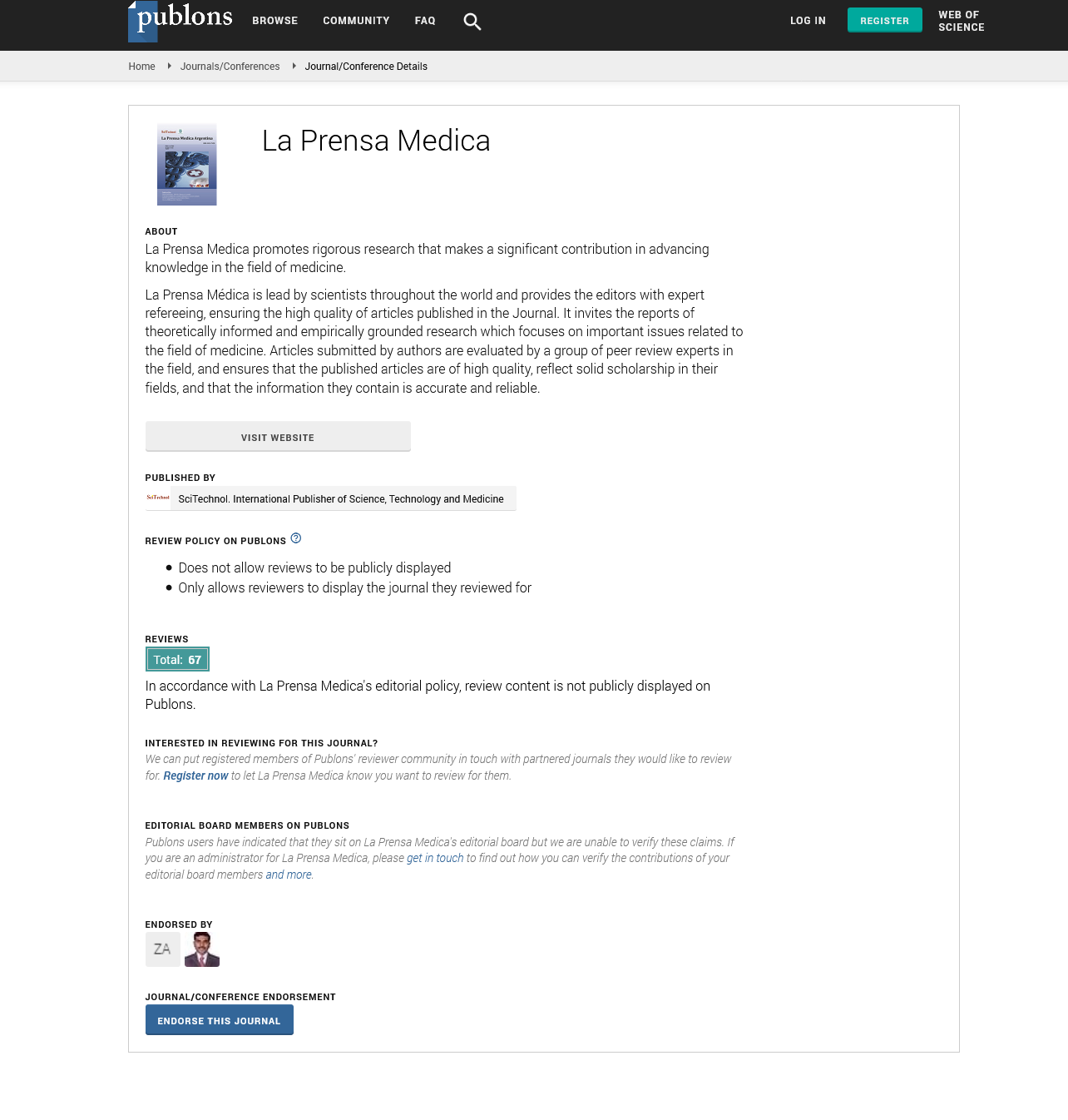Short Article, La Prensa Medica Vol: 109 Issue: 2
Dysregulated Healing and Fibrosis: An Overview
Alexandra Callaway*
1Department of Anesthesia, Intensive Care and EMS, Maggiore Hospital, Bologna, Italy
*Corresponding Author: Alexandra Callaway,
Department of Anesthesia, Intensive
Care and EMS, Maggiore Hospital, Bologna, Italy
E-mail: axcallaway69@hsr.it
Received date: 25 April 2023, Manuscript No. LPMA-23-102728
Editor assigned date: 27 April 2023, PreQC No. LPMA-23-102728 (PQ);
Reviewed date: 12 May 2023, QC No. LPMA-23-102728;
Revised date: 19 May 2023, Manuscript No. LPMA-23-102728 (R);
Published date: 26 May 2023, DOI: 10.4172/ 0032-745X.1000157
Citation: Callaway A (2023) Dysregulated Healing and Fibrosis: An Overview. La Prensa Medica 109:2.
Abstract
Description
Dysregulated healing and the subsequent development of fibrosis represent complex processes that occur in response to chronic inflammation or tissue injury. While the body's natural healing mechanisms are designed to restore tissue integrity, aberrant signaling pathways can lead to excessive extracellular matrix production, resulting in fibrosis [1]. This study provides an overview of dysregulated healing and fibrosis, highlighting the underlying mechanisms, common associated diseases, and current research efforts aimed at understanding and managing these conditions.
Understanding dysregulated healing
Healing is a dynamic and intricate process involving a series of well-orchestrated events, including inflammation, cell proliferation, and tissue remodeling. However, in cases of dysregulated healing, the tightly regulated balance is disrupted, leading to the accumulation of fibrous tissue [2]. Dysregulated healing can arise from various factors, including persistent inflammation, repetitive tissue injury, genetic predisposition, and impaired cellular responses [3]. During dysregulated healing, pro-inflammatory cytokines and growth factors are chronically released, stimulating fibroblast activation and collagen synthesis. This excessive collagen production and deposition surpasses the normal reparative needs, resulting in the formation of fibrotic tissue. The abnormal deposition of extracellular matrix components, such as collagen, disrupts tissue architecture and compromises organ function [4].
Common diseases associated with fibrosis
Fibrosis can affect multiple organs and systems, contributing to various chronic diseases. Some notable examples include liver cirrhosis, pulmonary fibrosis, kidney fibrosis, heart fibrosis, and systemic sclerosis. In liver cirrhosis, sustained injury and inflammation lead to the progressive replacement of functional liver tissue with fibrous scar tissue, impairing liver function [5]. Pulmonary fibrosis is characterized by the excessive accumulation of collagen in lung tissue, leading to diminished lung capacity and impaired gas exchange. Kidney fibrosis occurs as a result of chronic kidney injury, contributing to renal dysfunction and eventual kidney failure. Heart fibrosis is often associated with conditions like hypertension and myocardial infarction, leading to the stiffening of cardiac tissue and compromised cardiac function. Systemic sclerosis involves widespread fibrosis affecting multiple organs, including the skin, lungs, and gastrointestinal tract, causing significant morbidity [6].
Current research and treatment strategies
Understanding the underlying mechanisms of dysregulated healing and fibrosis is pivotal for the development of effective treatment strategies. Researchers are actively investigating the molecular pathways involved in fibrosis, aiming to identify potential therapeutic targets [7]. Several key pathways and molecules have been implicated, including Transforming Growth Factor (TGF), Connective Tissue Growth Factor (CTGF), and various cytokines and chemokines [8]. Emerging therapeutic approaches focus on inhibiting or modulating these key molecular targets involved in fibrotic processes. Small molecule inhibitors, antibodies, and RNA-based therapies are being explored to disrupt fibrosis-associated signaling pathways. Additionally, interventions targeting immune dysregulation and oxidative stress are being investigated [9]. Preclinical studies and clinical trials are evaluating the efficacy of novel compounds and therapeutic strategies in animal models and patient populations. Animal models of fibrosis, such as bleomycin-induced pulmonary fibrosis or carbon tetrachloride-induced liver fibrosis, provide valuable insights into disease mechanisms and potential interventions [10].
Conclusion
Dysregulated healing and fibrosis represent intricate processes that can lead to significant organ dysfunction and morbidity. The understanding of the underlying mechanisms involved in fibrosis is expanding, opening up possibilities for targeted therapies and interventions. Ongoing research efforts hold possibilities for the development of novel treatments to halt or reverse fibrosis, potentially transforming the management of fibrotic diseases. By unravelling the complexities of dysregulated healing and fibrosis, researchers and clinicians strive to improve patient outcomes and enhance the quality of life for individuals affected by these conditions.
References
- Parola M, Pinzani M (2019) Pathophysiology of organ and tissue fibrosis. Mol Aspects Med. 65(2): 1.
- Steele MP, Speer MC, Loyd JE, et al. (2005) Clinical and pathologic features of familial interstitial pneumonia. Am J Respir Crit Care Med 172: 1146-1152.
- Wynn TA (2007) Common and unique mechanisms regulate fibrosis in various fibro proliferative diseases. J Clin Invest. 117(3): 524– 529.
- Chiaramonte MG, Cheever AW, Malley JD, Donaldson DD, Wynn TA (2001) Studies of murine schistosomiasis reveal interleukin-13 blockade as a treatment for established and progressive liver fibrosis. Hepatology. 34: 273-282.
- Vennervald BJ, Dunne DW (2004) Morbidity in schistosomiasis: an update. Curr Opin Infect Dis. 17(5): 439-447.
- Rosenkranz S (2004) TGF-beta1 and angiotensin networking in cardiac remodeling Cardiovasc Res. 63(3):423-432.
- Strieter RM, Gomperts BN, Keane MP (2007) The role of CXC chemokines in pulmonary fibrosis. J Clin Invest. 117(3): 549-556.
- Metz CN (2003) Fibrocytes: a unique cell population implicated in wound healing. Cell Mol Life Sci. 60:1342-1350.
- Quan TE, Cowper SE, Bucala R (2006) The role of circulating fibrocytes in fibrosis. Curr Rheumatol Rep. 8(2): 145-150.
- Abraham DJ, Varga J (2005) Scleroderma: from cell and molecular mechanisms to disease models. Trends Immunol. 26:587-595.
 Spanish
Spanish  Chinese
Chinese  Russian
Russian  German
German  French
French  Japanese
Japanese  Portuguese
Portuguese  Hindi
Hindi 

